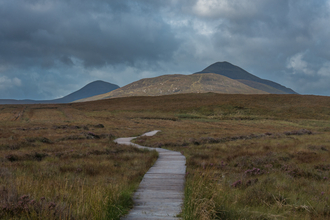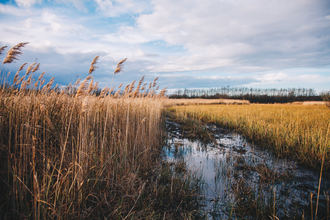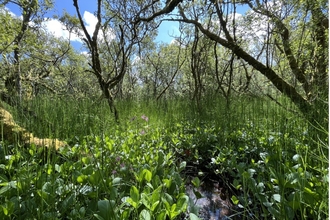The word ‘peatland’ often evokes images of waterlogged, treeless environments blanketing the landscape, but peatlands cover a variety of habitats that can look strikingly different from each other. In the UK, you may come across blanket bogs in the upland hills or raised bogs that dot the lowlands, as well as fens covered with lush vegetation and different types of wet woodlands. Intertidal and submerged peat deposits are also found along the coastline, where peat accumulated before the sea rose to present-day levels.
From tropical peatlands to snowy tundra
Elsewhere in the world, peatlands can resemble forests; for example, the tropical peat forests of Africa, Asia and Central- and South America, or the Fennoscandian peatlands covered by stunted trees. Peat also accumulates in the vast, treeless Arctic permafrost tundra and the high mountains of the Andes and Himalayas. Deposits have even been found in Antarctica, where peat accumulated millennia ago. To see what different peatlands around the world look like, explore the Globe on the ground floor of our interactive Virtual Peatlands Pavilion.
Habitat mosaics
In fact, there are just two basic types of peatland - those fed predominantly by surface water/groundwater (minerotrophic fens), and those fed only by rainwater and other forms of precipitation, having no contact with the groundwater (ombrotrophic bogs). However, transitions between fens and bogs (as well as other habitats) exist, and all these types can exist side by side, creating complex mosaics of interconnected habitats, supporting a variety of biodiversity.
On a landscape scale, all bog systems in their natural state are accompanied by fen systems – the two are either intertwined or fens can be found around the margins of bogs. Large areas of blanket bogs are therefore often a complex network of ombrotrophic bogs and fen units fed also by springs and seepages.
Instead of underlying hydrology, peatland habitats are thus often defined based on the predominant vegetation – for example, terms such as ‘bog woodland’ or ‘fen carr’ are not based on the peatland type but rather the surface vegetation, as bog woodlands are typically rainfall-fed bogs, and fen carrs are often a transition state between a fen and a drier woodland.
Blanket mire mosaic of blanket bog and fen, Caithness. Credit Richard Lindsay.
Wooded peatlands
Wooded peatlands are less well-known but are a natural ecosystem of the UK. These are peatlands that naturally have trees as part of their ecology. The tree cover in wooded peatlands can be dense (closed canopy) or sparse (semi-open or open canopy). The two most common types of forested peatland are broadleaved wet woodland (carr) and bog woodland.
Plantations on drained peatlands are not considered wooded peatlands, as these ecosystems would naturally be largely treeless. Such plantations are commonly used for commercial production of non-native timber such as Sitka spruce, Douglas fir and Norway fir, and have been planted across large tracts of bogs in the UK.
Wooded peatlands are rare in the UK due to a combination of historical land-use changes, intensive agricultural practices, and drainage for development. Many remaining wooded peatlands have been fragmented and degraded by modern land-use pressures, and these pressures are further exacerbated by climate change.
The conservation of wooded peatlands is further hampered by a lack of awareness of their ecological and carbon sequestration benefits. Restoration efforts are often constrained by competing land-use priorities and insufficient knowledge of effective management strategies for these unique habitats.
*We thank the Wet Woodland Research Network for their valuable input to this content,
Terminology
There are many more widely used terms related to peatlands. Mire is an actively peat-forming system. Healthy, peat-forming peatlands are therefore mires, but peatlands damaged by the removal of vegetation are no longer peat-forming and cannot be described as mires. However, these damaged habitats can still be called peatlands due to the presence of peat soils.
Moorland is also widely used to describe open upland landscapes, but this term does not describe a single habitat: it embraces upland heath and upland grassland as well as blanket bog and therefore often causes confusion. The first two habitats are not wetlands and are quite distinct in their functioning from blanket bog; they also do not store substantial quantities of carbon, and often occur over mineral soils. When blanket bog is damaged it can superficially resemble either upland heath or upland grassland, but its underlying processes remain those of a wetland. The term moorland should therefore be used with caution in scientific studies.
Click on the tiles below to explore the different peatland habitats found in the UK.




